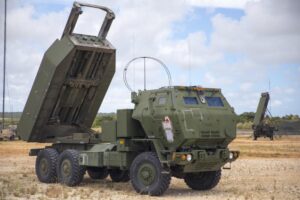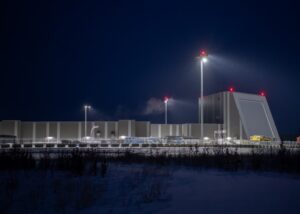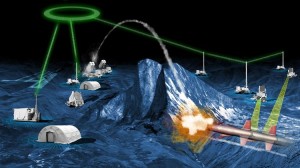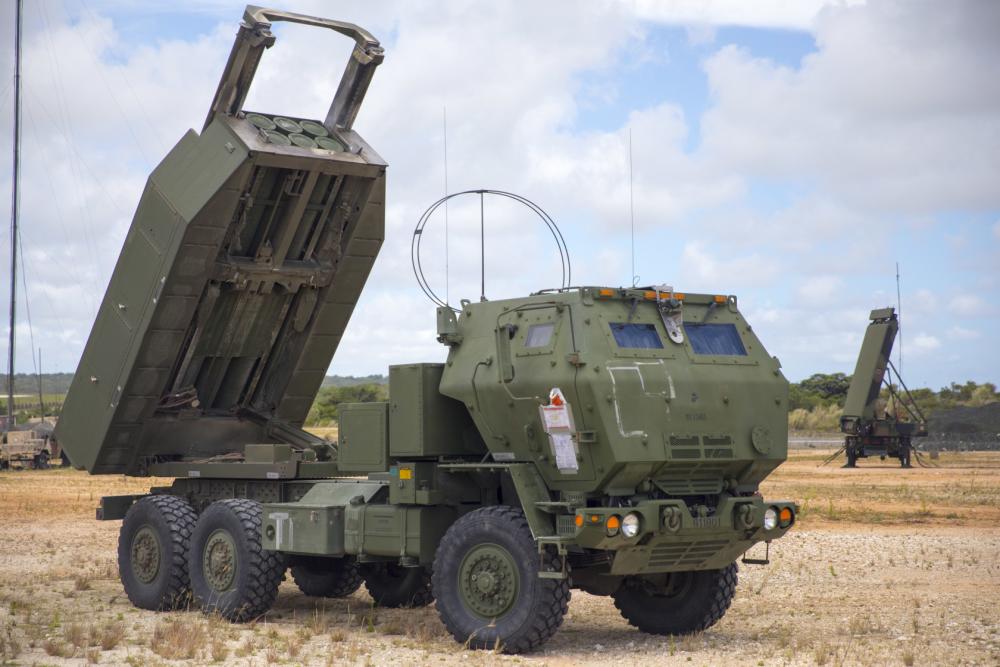The “first string” of interceptors, launchers, radars and a command and control system for missile defenses set to be deployed to Guam will arrive in 2024, the director of the Missile Defense Agency (MDA) said last week.
The Guam architecture, “however you want to define that, was really dictated by the budget in ‘23 that that that tells you what we’re going to go do, which is a combination of Aegis and [Integrated Air and Missile Defense Battle Command System (IBCS)],” MDA Director Vice Adm. Jon Hill told reporters during the McAleese Defense Programs conference on March 15.

MDA’s recently released fiscal year 2024 budget request devotes $801 million to start building and continue developing the Guam defense architecture (Defense Daily, March 14).
Last year MDA first announced its chosen architecture to defend Guam from air and missile threats will include mobile unit versions of the Aegis Combat System, Raytheon Technologies [RTX] Standard Missile (SM)-3 and SM-6 missiles, and the Northrop Grumman [NOC] IBCS while also maintaining the THAAD system battery already deployed on Guam (Defense Daily, March 29, 2022).
Hill said the Army’s IBCS will be part of the command and control system once it is ready to deploy and the Army has soldiers aligned to it. While waiting for IBCS, MDA is developing interfaces to connect it with the Aegis command and control systems, “which will be different than what we have on the ship. And it’s different than what we have at Aegis Ashore in Europe.”
The IBCS will ultimately include the Raytheon Lower Tier Air and Missile Defense Sensor (LTAMDS) and Sentinel radars to defend against cruise missiles and hypersonic weapons.
Beyond command and control, Hill said the first set of Guam systems will include four new AN/TPY-6 radars using the same technology in the Long Range Discrimination Radar (LRDR) at Clear Space Force Base, Alaska.
These radars will be mobile but posted to “the periphery of the islands, so that gives us 360-degree coverage,” which was a primary requirement from U.S. Indo-Pacific Command (INDOPACOM).
Hill noted these systems are not focused only on defending against ballistic missile threats from North Korea, but also defending against China, referred to as a “near peer threat,” requiring them to add new discrimination algorithms for the “higher end threat.”
He said part of the radar deployment requires mechanical engineering work to deploy radars that are usually on the deckhouse of a ship or a large facility like in Alaska and “and we’re putting those in erectable trailers so that we can move them around and emplace them.”
Hill said once MDA’s Glide Phase Interceptor hypersonic defense program is ready, it will be added to the Guam systems. Until then, the Navy is providing its Aegis weapon system technology in the first phase to help defend against ballistic missiles in the terminal phase as well as provide some defense against hypersonic weapons.
The interceptors will ultimately be launched from a new mobile version of the Army MK41 Vertical Launch System (VLS) and a new Army midrange missile launcher.

“So really it’s an incremental path, so there is no end state. So if you ask me what the [Initial Operating Capability date] is, I will look at you and say that there isn’t one, because we’re going to deliver capability as it’s ready, and we’re going to continue to build it out,” the MDA director said.
Hill noted he committed to Adm. John Aquilino, commander of INDOPACOM, a first string of capabilities including the first radars, launchers, and initial command and control suite in 2024. “We’re going to be running on engineering loads, but that’s okay,” he said.
Hill underscored the command suite issue is one of the biggest issues for Aquilino, since control in the Pacific theater is currently based at Joint Base Pearl Harbor–Hickam, Hawaii.
“That’s pretty far away from the fight, right? So Guam gets them closer with their command suite and right now it’s IBCS, the controller there, we have controllers for Aegis and then we put them all together in our command control battle management system. So that’s that’s the architecture.”
Hill also detailed the challenges in putting this system together, largely focused on limited space and dealing with putting this new architecture in a tourist destination.
Right now Hill said his main challenges on Guam are deploying assets on the right sites as MDA works with the Army and Navy. That entails finding the right locations, going through environmental reviews, clearing the sites, and a commitment to minimize interference and obvious military systems at a tourist destination.

“So we have all the sites identified on the island today, we know which are the Army sites, we know which are the MDA sites. It’s a Navy island, so when I say we have a partnership with the Army, I’m speaking to IBCS. When I say we have a partnership with the Navy – Navy’s the landlord and Aegis is a Navy system. So that’s our biggest challenge.”
Hill added it will also add time to go through the National Environmental Policy Act (NEPA) process with its environmental assessments before much of the equipment can be deployed. However, MDA will start by deploying initial systems on Andersen Air Force Base.
“We’re going to go to Andersen Air Force Base. You’ve got runways there, you’ve got existing infrastructure that we can tap into. But in the future, we will move that and put it in other places, depending on how we do on the whole process. So that’s the big headache today – is what it takes to get through NEPA,” Hill said.
Guam notably ‘has a boatload of expended ordnance on it from World War II,” so when DoD clears and flattens the bamboo laden land, they also have to dig down to catch any old ordnance, the director said.
“It’s a really, really tough challenge…There’ll be more [challenges] as we go.”
To minimize tourist and resident issues, Hill said they need to minimize any radar electromagnetic interference with civilian infrastructure and that they “committed to beautify them.”
“So we’re going to make launchers look beautiful. And we’re gonna put big bubbles over the radars to keep them from looking so lethal. Because it is a tourist area. Just the reality is, that’s what it is,” Hill added.
